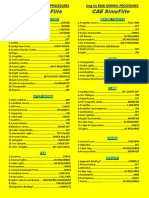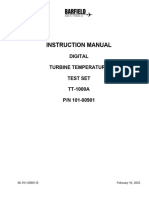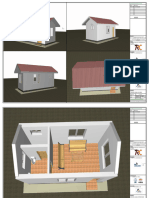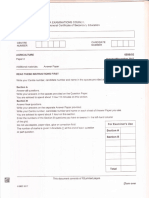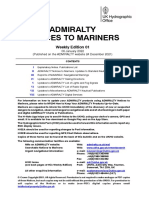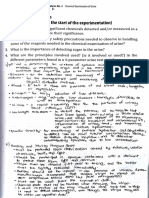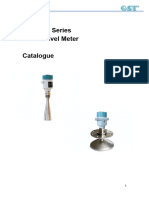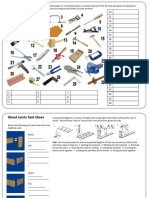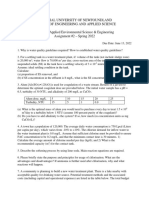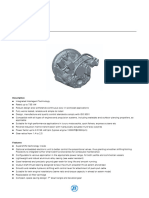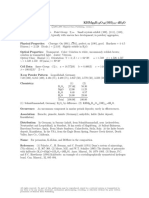C1-2-S2 - Self Check
Uploaded by
Nestor LucianiC1-2-S2 - Self Check
Uploaded by
Nestor LucianiCitation CI/CII/SII
Self-Check Exercises
May 2010
Copyright © 2010, CAE SimuFlite, Inc.
All rights reserved.
Excerpted materials used in this publication
have been reproduced with the permission of
Cessna Aircraft Company.
Printed in the United States of America.
Orientation
Welcome to CAE CAE SimuFlite Training International welcomes you to one of the world’s
premier aviation training facilities. Our goal is to provide training that
increases your ability to operate your aircraft at the highest professional
standards. In pursuit of this goal, we conduct training in accordance with
Airline Transport Pilot (ATP) standards to ensure a level of competency and
safety unsurpassed in the business aviation industry.
Use of these
CAE SimuFlite developed these exercises to reinforce your training.
Self-Check The questions parallel your course. Refer to your training guide for
Exercises completion schedule of exercises.
Citation CI/CII/SII For Training Purposes Only 1
May 2010
This page intentionally left blank.
2 For Training Purposes Only Citation CI/CII/SII
May 2010
Contents
Table of Contents Self-Checks
Self-Check 1 . . . . . . . . . . . . . . . . . . . . . . . . . 5
Self-Check 2 . . . . . . . . . . . . . . . . . . . . . . . . 11
Self-Check 3 . . . . . . . . . . . . . . . . . . . . . . . . 21
Self-Check 4 . . . . . . . . . . . . . . . . . . . . . . . . 25
Self-Check 5/6 . . . . . . . . . . . . . . . . . . . . . . . 27
Answer Keys
Self-Check 1 Answer Key . . . . . . . . . . . . . . . . . 33
Self-Check 2 Answer Key . . . . . . . . . . . . . . . . . 35
Self-Check 3 Answer Key . . . . . . . . . . . . . . . . . 37
Self-Check 4 Answer Key . . . . . . . . . . . . . . . . . 39
Self-Check 5/6 Answer Key . . . . . . . . . . . . . . . . 41
Citation CI/CII/SII For Training Purposes Only 3
May 2010
This page intentionally left blank.
4 For Training Purposes Only Citation CI/CII/SII
May 2010
Self-Check 1
Self-Check 1
Aircraft Overview Reference: Technical Manual (Chapter 9)
Fill in the Blank
1. The __________ door is not monitored by the DOOR NOT LOCKED
light.
2. The nose baggage compartment light is connected to the ________
bus and will not be illuminated when both nose baggage doors are
closed.
Citation CI/CII/SII For Training Purposes Only 5
May 2010
Electrical/ Reference: Technical Manual (Chapter 11)
Lighting Multiple Choice Questions
1. The GCUs in the tailcone provide which of the following?
A. Voltage regulation
B. Feeder and ground fault protection
C. Overvoltage protection
D. Load sharing
E. All of the above
2. What normally terminates an engine start sequence?
A. Motive flow pressure switch
B. Start disengage button
C. 38% N2 speed sensing
3. A cross-generator assisted start counts as _______ of a battery start.
A. one-quarter
B. one-third
C. one-half
4. The _______ bus powers the cockpit floodlights when the battery switch
is in the emergency position.
A. Hot Battery
B. Battery
C. Emergency
5. Normal generator voltage output is ______ VDC.
A. 24
B. 28.5
C. 30
6. Maximum continuous generator output in flight below FL350 is ______
amps.
A. 400
B. 225
C. 300
6 For Training Purposes Only Citation CI/CII/SII
May 2010
Self-Check 1
True or False
1. ____The voltmeter can read Hot Battery bus voltage with the battery
switch in the OFF position.
2. ____The BATT O’HEAT/O’TEMP annunciator flashes with a battery
temperature of 145°F.
3. ____An external power unit charges the aircraft battery with the battery
switch in the OFF position.
4. ____The aircraft inverters have an output of 115 VAC and 26 VAC at
400 Hz.
5. ____The GPU should be disconnected when not operating to prevent
battery drain and damage due to reverse current.
6. ____Two crossover buses serve to group like items together on one
CB panel.
Fill in the Blank
1. The Citation requires an external power unit rated at _____ VDC and a
maximum of ______ amps.
2. The aircraft battery is rated at _______ VDC and _______ amps per
hour capacity.
3. With the battery switch in OFF and the engines not running, the battery
powers the _____ bus.
4. With no generators online and the battery switch in emergency, the
battery will power the Emergency bus for at least _______ minutes.
5. The starter limitation with the battery as the power source, is _______
engine start(s) per ______ minute(s) with a _______ second rest
period.
6. Selecting BATT TEMP on the rotary test switch tests the battery
overheat warning system by simulating a ________ battery temperature
condition.
7. The starter limitation with a ground power unit or generator-assisted
cross start as the power source is ______ engine start(s) in ______
minute(s) with a ______ second rest period.
8. The battery is limited to ______ engine start(s) per hour.
9. The standby gyro battery pack provides power to the lights of the
following instruments in the CII: ________________________,
____________________________, ________________________,
____________________________, ________________________.
Citation CI/CII/SII For Training Purposes Only 7
May 2010
Hydraulics Reference: Technical Manual (Chapter 15)
True or False
1. ____The hydraulic system operates at 1,500 PSI continuously.
2. ____The engine-driven hydraulic pumps can operate without fluid
indefinitely.
3. ____The Citation utilizes an open-center type hydraulic system.
Fill in the Blank
1. The hydraulic level low annunciator illuminates when the hydraulic
reservoir contains ________ U.S. gallon.
2. List the systems powered by the main hydraulic system.
CI/CII: __________________________________________________
_______________________________________________________
SII: ___________________________________________________
______________________________________________________
3. The type of hydraulic fluid required for the Citation is __________.
8 For Training Purposes Only Citation CI/CII/SII
May 2010
Self-Check 1
Landing Gear/ Reference: Technical Manual (Chapter 17)
Brakes True or False
1. ____ Once the landing gear is down and locked, hydraulic pressure is
used to ensure a positive lock.
2. ____ Pneumatic pressure from the emergency air bottle provides a
backup power source for the brakes and gear downlock.
3. ____ The anti-skid is operative for takeoff only if the self-test is conducted
while taxiing.
4. ____When fully charged, the emergency air bottle contains sufficient
pressure for emergency braking if landing gear auxiliary extension was
used.
5. ____ An electric hydraulic pump provides hydraulic power for the
anti-skid brakes.
Multiple Choice Questions
1. Which of the following statements is true concerning the landing gear
auxiliary extension system?
A. Pulling the red T-handle unlocks the uplocks and discharges the
pneumatic air bottle.
B. The red T-handle must be rotated 45° and locked before the red
blowdown knob can be pulled.
C. The landing gear can be hydraulically raised after the pneumatic air
bottle has been activated.
2. Which of the following statements is most correct for the nosewheel
steering when the aircraft is being towed?
A. Electrical power must be removed from the Main DC buses.
B. The towing limit is 60° either side of center at all times.
C. The control lock must be disengaged to allow a tow limit of 95°
either side of center.
3. Which of the following statements is true if the anti-skid switch is turned
OFF and then ON during taxi?
A. The anti-skid operates normally when the system is on
B. The anti-skid is inoperative
C. The power brakes are inoperative
Citation CI/CII/SII For Training Purposes Only 9
May 2010
Fill in the Blank
1. List the maximum landing gear speeds.
A. VLE ________
B. VLO (extend) ______
C. VLO (retract) _______
2. The landing gear is controlled _______ and actuated _________.
3. The landing gear is held in the UP position by _______ and locked in
the DOWN position by ________.
4. (SII) The landing gear warning horn does not sound above _______
KIAS if either throttle is retarded below 70% N2.
5. The nosewheel turning limit is ______ ° with the control lock off and
_______ ° with the control lock engaged.
10 For Training Purposes Only Citation CI/CII/SII
May 2010
Self-Check 2
Self-Check 2
Powerplant/ Reference: Technical Manual (Chapter 20)
Thrust Reversers Multiple Choice Questions
1. Which bus powers the N1 fan speed tape indicator?
A. Emergency bus
B. Hot Battery bus
C. None
2. Which of the following occurs with failure of one ignition igniter?
A. Engine does not start
B. Engine hot starts
C. Engine starts normally
3. Engine bleed air continuously provides ice protection for which of the
following?
A. Bullet nose and T1 probe
B. Bullet nose, T1 probe, and engine inlet
C. Bullet nose, T1 probe, and inner stator vanes
4. When should engine oil quantity be checked for an accurate reading?
A. During preflight
B. Within 10 minutes after engine shutdown
C. Within 30 minutes after engine shutdown
5. What is the maximum ITT allowed during engine start?
A. 500°C
B. 710°C
C. 700°C
6. With the ignition switches in NORMAL, which of the following provides
automatic ignition?
A. Engine anti-ice ON
B. Throttle out of cutoff during ground start
C. A and B
7. Which of the following best describes the thrust reverser system?
A. Hydraulically actuated, cable-controlled
B. Hydraulically actuated, electrically controlled
C. Pneumatically actuated, electrically controlled
8. Which of the following statements is true about the thrust reverser
system?
A. Thrust reversing during touch-and-go landings is permitted
B. Maximum reverse thrust is permitted to a full stop
C. Thrust reversing is prohibited on sod and gravel runways
Citation CI/CII/SII For Training Purposes Only 11
May 2010
Fill in the Blank
1. The Pratt and Whitney JT15D-4 turbofan engine produces ________
pounds of static thrust at sea level.
2. The engine oil tank has a capacity of ______ U.S. gallons; of this,
______ U.S. gallons are usable.
3. The engine oil cooler transfers heat from the oil to _________.
4. The items driven by the accessory gearbox are the:
___________________________, _________________________,
___________________________, _________________________,
and ______________________.
5. The low oil pressure warning annunciator illuminates if the oil pressure
drops to approximately ______ PSI.
6. The N2 idle RPM should be approximately ________.
7. The engine synchronizer matches the _______ (slaved) engine to the
__________ (master) engine.
8. Reverse engine power should be reduced to idle reverse by ________
KIAS during landing.
9. The maximum time that the thrust reversers can be deployed in any
1-hour period is _______ minute(s).
10. The left emergency stow switch receives power from the _______
circuit breaker.
11. The maximum demonstrated crosswind component for thrust reverser
use is _______ knots.
12 For Training Purposes Only Citation CI/CII/SII
May 2010
Self-Check 2
Fire Detection/ Reference: Technical Manual (Chapter 12)
Protection Multiple Choice Questions
1. What is the correct indication for engine fire?
A. The red fire switchlight illuminates steadily
B. The red fire switchlight flashes
C. The red fire switchlight flashes and is accompanied by a fire
warning bell
2. The rotary test switch in the FIRE WARN position illuminates the
________.
A. Bottle armed lights
B. ENG FIRE switchlights
C. A and B
3. A portable fire extinguisher is in the cockpit _________.
A. Under the copilot’s seat
B. Under the pilot’s seat
C. Behind the copilot’s seat
True or False
1. ____ A total loss of main DC power does not affect the engine fire
warning and extinguishing system.
2. ____The F/W SHUTOFF annunciators illuminate when the fuel and
hydraulic firewall shutoff valves are closed.
3. ____The only method for checking engine fire extinguisher quantity is
to read the gauge on the bottle during preflight.
Fill in the Blank
1. Depressing the ENG FIRE switchlight causes the:
________________________, ________________________,
________________________, ________________________, and
________________________.
Citation CI/CII/SII For Training Purposes Only 13
May 2010
Fuel Reference: Technical Manual (Chapter 14)
Multiple Choice Questions
1. The FUEL LOW LEVEL annunciator illuminates when the fuel level has
reached a minimum of ________ pounds.
A. 169
B. 170
C. 185
2. In cruise the primary ejector pumps receive motive flow fuel from the
_____ pumps.
A. Electric boost
B. Transfer ejector
C. Engine-driven fuel pump
3. The IN TRANSIT light illuminates when the ___________.
A. Crossfeed valves are cycling from one position to another
B. Motive flow valve cycles from one position to another
C. Crossfeed switch energizes the boost pump
4. Which bus supplies electrical power for the fuel quantity instruments?
A. Emergency
B. Battery
C. Left/Right Main
5. (CII) The maximum fuel imbalance is _______ pounds.
A. 200
B. 600
C. 800
Fill in the Blank
1. The CII total fuel quantity is ________ U.S. gallons or _______ pounds.
The SII total fuel quantity is ________ U.S. gallons or _______ pounds.
2. List the three actions that activate the fuel boost pump with the boost
pump switch in NORM.
_____________________________________________________
_____________________________________________________
_____________________________________________________
3. The opposite motive flow shutoff valve is closed during ______
operation.
True or False
1. ____Total loss of electrical power during crossfeed operations results
in tank-to-engine operation.
2. ____When illuminated, the FUEL FILTER BYPASS annunciator
indicates impending or actual fuel filter bypass.
3. ____PRIST should be added to all fuels used in the Citation.
14 For Training Purposes Only Citation CI/CII/SII
May 2010
Self-Check 2
Flight Controls Reference: Technical Manual (Chapter 13)
Multiple Choice Questions
1. Which of the following statements is correct concerning the pilot’s
electric trim switch?
A. The pilot’s electric trim switch overrides the copilot’s electric trim
switch
B. Electric trim is powered from the Hot Battery bus
C. The copilot’s electric trim switch overrides the pilot’s electric trim
switch
2. Which of the following statements is correct if hydraulic power is lost?
A. The speedbrakes trail when the switch is placed in retract
B. The speedbrakes remain in the last position
C. The speedbrakes trail automatically
3. Which of the following occurs when the flaps are extended beyond
takeoff and approach with the landing gear up?
A. The landing gear warning horn can be silenced
B. The landing gear warning horn cannot be silenced
C. The landing gear warning horn sounds only if the aircraft is below
150 KIAS
True or False
1. ____ The control wheel, control column and rudder pedals actuate the
primary flight controls through cables and bellcranks.
2. ____ The control lock engages the ailerons in neutral, the elevator in
neutral, the rudder in neutral and the throttles in cutoff.
Fill in the Blank
1. The electric elevator trim can be disabled by pressing the ________.
2. List the actions that activate the electric pitch trim system.
_____________________________________________________
_____________________________________________________
_____________________________________________________
3. The yaw damper may be used for all phases of flight except
_______________________ and ____________________.
4. (SII) The flaps actuate the electric pitch trim when they move between
________° and _________°.
5. The maximum speed to extend the flaps to T.O. or T.O. & APPR position
is ________ KIAS.
6. The maximum speed to extend the flaps to the landing position is
________ KIAS.
7. Speedbrakes may be extended in flight any time except _______.
Citation CI/CII/SII For Training Purposes Only 15
May 2010
Pressurization/ Reference: Technical Manual (Chapter 21)
Environmental Fill in the Blank
1. The __________ switch controls all bleed air extracted from the engines
for pressurization.
2. Bleed air for emergency pressurization comes from the ________
engine.
3. The cabin outflow valves maintain a maximum cabin pressure differential
of _____ PSID.
4. During flight, the pressurization controller operates the outflow valves
utilizing _______ as a power source.
5. The emergency dump valve utilizes _________ to open the outflow
valves.
True or False
1. ____The pressurization controller requires electrical power for the
flight/cruise mode.
2. ____Selecting GND on the source selector opens the ground valve and
closes both the left and right flow control valves.
16 For Training Purposes Only Citation CI/CII/SII
May 2010
Self-Check 2
Multiple Choice Questions
1. The left flow control valve allows a minimum flow rate of ______ pounds
per minute.
A. 8
B. 6
C. 12
2. The ground valve allows approximately _____ pounds per minute
flow.
A. 14
B. 16
C. 18
3. The door seal inflates and deflates through the door seal valve controller
by the _________.
A. Lower forward cabin door pin
B. Left main gear squat switch
C. Pressure source select switch
4. With the pressure source selector in NORMAL, emergency dump at
the aircraft service ceiling results in a cabin altitude of approximately
______ feet.
A. 35,000
B. 13,000
C. 3,000
5. The emergency pressurization valve opens ________.
A. On the ground when EMER PRESS is selected.
B. Automatically (in flight or on the ground) or if selected
C. Only in flight (either automatically or if selected)
Citation CI/CII/SII For Training Purposes Only 17
May 2010
Ice and Rain Reference: Technical Manual (Chapter 16)
Protection True or False
1. ____The engine anti-ice valves open if main DC power is lost.
2. ____The windshield bleed air system requires that the manual valves
be closed for proper windshield defogging.
3. ____The windshield alcohol system supplies 10 minutes of anti-icing to
the pilot and copilot windshields.
4. ____The high and low positions of the windshield bleed air switch
control the supply air temperature.
Multiple Choice Questions
1. To achieve the maximum protection from windshield fogging, which of
the following should be selected 15 minutes prior to descent?
A. DEFOG fan on low
B. DEFOG fan on high and windshield bleed on low
C. Windshield bleed air on low
2. When taxiing in icing conditions, operate the engines above _____N2
(ensure engine anti-ice lights out) at least 1 out of every 4 minutes.
A. 60
B. 70
C. 80
3. The engine anti-ice system requires a minimum of ______% N2 to open
the engine anti-ice valves.
A. 80
B. 70
C. 60
Fill in the Blank
1. The engine anti-ice systems must be used when operating in visible
moisture with an indicated OAT of ______ °C or below.
2. The engine anti-ice annunciator monitors temperature for the _______
and ________ systems.
3. The surface deice annunciator should illuminate ________ times during
the deice cycle.
4. The high position of the windshield bleed air switch should be selected
when the OAT is ______°C or below.
5. On the ground, the pitot/static heat should not be on for more than
_______ minutes.
6. The ________ position of the surface deice switch deflates all the boots
simultaneously.
18 For Training Purposes Only Citation CI/CII/SII
May 2010
Self-Check 2
SII ONLY, True or False
1. ____Outboard wing and tail surface TKS fluid coverage occurs with the
LH/RH ENGINE anti-ice switches in LOW.
2. ____Surface anti-ice is activated for 5 minutes at a time.
3. ____The WING ICE FAIL light illuminates when icing is detected and
the SURFACE ANTI-ICE switch is in OFF/RESET.
4. ____The TAIL ICE FAIL light illuminates when fluid pressure is below
2.5 PSI to one or more of the horizontal stabilizer panels.
5. ____The TKS reservoir is sufficient for 9 hours of continuous use of
surface anti-ice.
6. ____If both engine anti-ice switches are in HI and the surface antiice
switch is in ENG (1) TKS flows to the inboard leading wing cuff and
fairing at the normal rate, and (2) the engine bleed air is on.
7. ____Bleed air flow is the same regardless of the position of ENGINE
ANTI-ICE switches.
Citation CI/CII/SII For Training Purposes Only 19
May 2010
This page intentionally left blank.
20 For Training Purposes Only Citation CI/CII/SII
May 2010
Self-Check 3
Self-Check 3
Flight Controls Reference: Technical Manual (Chapter 13)
Operating Handbook E-pages
Abnormals and
Fill in the Blank
Emergency 1. The VFE for flaps T.O. or T.O. & APPR is _______ KIAS.
Procedures 2. The VFE for the flaps in LAND position is ________ KIAS.
3. Autopilot operation is prohibited if the AP TORQUE light illuminates in
flight above _______ feet.
4. Do not use the autopilot with the ________________ inoperative.
True or False
1. ____The autopilot and yaw damper must be off for takeoff and
landing.
2. ____The Angle-Of-Attack (AOA) system may be used in place of the
airspeed indicators.
3. ____Autopilot operation above 14,500 feet is prohibited if the AP
TORQUE light illuminates in flight.
4. ____Normal landings in a Citation are full flap landings.
Citation CI/CII/SII For Training Purposes Only 21
May 2010
Electrical/ Reference: Technical Manual (Chapter 11)
Operating Handbook E-pages
Lighting
Abnormals and Write in the memory items.
Emergency
1. Electrical Fire or Smoke
Procedures ____________________________________________________
____________________________________________________
2. Environmental System Smoke or Odor
_____________________________________________________
_____________________________________________________
3. Battery Overheat
_____________________________________________________
_____________________________________________________
_____________________________________________________
True or False
1. ____If a dual INVERTER FAILURE occurs, placing the battery switch
into EMER provides AC power for copilot HSI compass and NAV 2.
2. ____With generators OFF and battery switch in EMER, the main battery
provides up to 1 hour operation of all cockpit flight instruments.
22 For Training Purposes Only Citation CI/CII/SII
May 2010
Self-Check 3
Hydraulics/ Reference: Technical Manual (Chapter 15 & 17)
Operating Handbook E-pages
Landing
Fill in the Blank
Gear/Brakes 1. The maximum landing gear extended speed (VLE) is ______ KIAS.
Abnormals and 2. The maximum landing gear operating speed (VLO) for extension is
Emergency _______ KIAS.
3. The maximum landing gear operating speed (VLO) for retraction is
Procedures ______ KIAS.
4. The maximum tire groundspeed is _________ knots.
5. The maximum water or slush permitted on a runway is ______
inch(es).
True or False
1. ____The HYD FLOW LOW/HYD PRESS LOW annunciators indicate
pump output is less than 0.35 GPM.
2. ____If both hydraulic pumps fail, the speedbrakes, flaps, thrust reversers,
landing gear, and wheel brakes are inoperative.
3. ____The landing gear must be lowered by emergency procedures if the
hydraulic system remains pressurized.
4. ____If the hydraulic system bypass valve fails in the closed position,
the HYD PRESS ON light remains ON after operation of a subsystem.
5. ____ If the power brake pressure low and anti-skid inoperative lights
illuminate simultaneously, a power brake failure is indicated.
Citation CI/CII/SII For Training Purposes Only 23
May 2010
This page intentionally left blank.
24 For Training Purposes Only Citation CI/CII/SII
May 2010
Self-Check 4
Self-Check 4
Avionics Reference: Technical Manual (Chapter 10)
Fill in the Blank
1. The pilot’s altimeter receives information from the ________.
2. MMO is __________ M.
3. VMO above 14,000 feet is _________ KIAS.
4. VMO below 14,000 feet is ________ KIAS.
5. The cockpit voice recorder erase button is only functional on the
_________.
6. The autopilot bank limit switch (if installed) limits bank angle to
__________.
7. The copilot’s navigation information can be used by the flight director or
autopilot when the _______________________________ _________
________________________________________.
True or False
1. ____ The AOA system may be used in place of indicated airspeed.
2. ____ (Unit 627 and sub.) The Primus 650 WX weather radar can transmit
on the ground when both range buttons are pushed simultaneously.
3. ____ Both pilots must remain in their seats with seat belts fastened
during autopilot operation.
4. ____ Autopilot operation is prohibited if the AP TORQUE annunciator
illuminates in flight below 14,500 ft.
5. ____ (Unit 627 and sub.) If an EADI or EHSI fails, the operating
indicator can be used in the composite mode with or without the flight
director selected.
6. ____ The glideslope can be captured from either above or below.
Citation CI/CII/SII For Training Purposes Only 25
May 2010
This page intentionally left blank.
26 For Training Purposes Only Citation CI/CII/SII
May 2010
Self-Check 5/6
Self-Check 5/6
Avionics Reference: Technical Manual (Chapter 10)
Operating Handbook E-pages
Abnormals and
Fill in the Blank
Emergency 1. Operating the EFIS system in the __________ mode is approved only
Procedures with the flight director selected.
2. Excessive temperature in the avionics compartment illuminates the
________ annunciator.
3. Loss of the ________ renders the entire EFIS system inoperative.
4. If the EADI or EHSI HOT annunciators illuminate in flight, use the
______ to provide additional system cooling.
5. The NAV 1/NAV 2 button transfers __________, _________, and
_________ information from the copilot’s HSI to the pilot’s flight
director.
True or False
1. ____An SG HOT message on the EFIS display indicates a symbol
generator overheat due to fan failure.
2. ____If the MFD SG HOT light appears on the multifunction display, pull
the EFIS CBs to reset the system.
3. ____If the EFIS cooling fan fails on the ground, pull the applicable CBs
and limit ground operation to 20 minutes.
4. ____The EFIS system can provide a combined EADI and EHSI on one
display.
5. ____The autopilot altitude hold mode should not be engaged with the
MFD SYM GEN CB open.
6. ____Pressing the NAV button on the EFIS controller changes the
navigation source from NAV 1 to NAV 2.
Citation CI/CII/SII For Training Purposes Only 27
May 2010
Powerplant/ Reference: Technical Manual (Chapter 20)
Operating Handbook E-pages
Thrust Reversers
Abnormals and Write in the memory items.
Emergency 1. Engine Failure During Coupled Approach
_____________________________________________________
Procedures _____________________________________________________
_____________________________________________________
_____________________________________________________
_____________________________________________________
2. Engine Fire
_____________________________________________________
_____________________________________________________
_____________________________________________________
3. Emergency Restart – Two Engines
_____________________________________________________
_____________________________________________________
_____________________________________________________
4. Engine Failure/Fire During Takeoff/Speed Below V1
_____________________________________________________
_____________________________________________________
_____________________________________________________
_____________________________________________________
_____________________________________________________
5. Engine Failure/Fire During Takeoff/Speed Above V1
_____________________________________________________
_____________________________________________________
_____________________________________________________
6. Inadvertent Thrust Reverser Deployment in Flight
_____________________________________________________
_____________________________________________________
_____________________________________________________
_____________________________________________________
7. Inadvertent Thrust Reverser Deployment During Takeoff/Speed
Below V1
_____________________________________________________
_____________________________________________________
_____________________________________________________
28 For Training Purposes Only Citation CI/CII/SII
May 2010
Self-Check 5/6
8. Inadvertent Thrust Reverser Deployment During Takeoff/Speed
Above V1
_____________________________________________________
_____________________________________________________
_____________________________________________________
_____________________________________________________
9. Thrust Reverser Unlock Light – On in Flight
_____________________________________________________
_____________________________________________________
Fill in the Blank
1. The minimum oil temperature for engine start is _____°C.
2. The maximum gross landing weight is limited by:
_____________________________________________________
_____________________________________________________
_____________________________________________________
3. The maximum gross takeoff weight is limited by:
_____________________________________________________
_____________________________________________________
_____________________________________________________
4. To open the firewall shutoff valves and reset the fire protection system
after pressing a fire switchlight, ____________.
5. Once a thrust reverser is emergency stowed, do not exceed _______
KIAS.
6. Illumination of the ARM light indicates that the hydraulic system is
pressurized and the ________ valve is open.
7. If inadvertent deployment of a thrust reverser occurs during takeoff, do
not exceed _________ KIAS until the reverser stows.
Citation CI/CII/SII For Training Purposes Only 29
May 2010
Fuel Abnormals Reference: Technical Manual (Chapter 14)
Operating Handbook E-pages
and Emergency
Fill in the Blank
Procedures 1. The maximum altitude for flight when using aviation gasoline is _______
feet.
2. (SII) The maximum fuel imbalance for emergency operations is
_________ pounds.
3. (SII) The maximum fuel imbalance for normal operation is _________
pounds.
True or False
1. ____Illumination of the FUEL LOW LEVEL light indicates fuel quantity
is below 165 pounds usable fuel in the designated tank.
2. ____The fuel firewall shutoff valves are motor-operated valves on the
firewall.
30 For Training Purposes Only Citation CI/CII/SII
May 2010
Self-Check 5/6
Ice and Rain Reference: Technical Manual (Chapter 16)
Operating Handbook E-pages
Protection
Fill in the Blank
Abnormals and 1. The windshield alcohol system requires ______ alcohol.
Emergency 2. The windshield alcohol system provides ______ minute(s) of alcohol
Procedures system operation.
3. The W/S BLEED AIR switch should be in the ________ position when
the OAT is above -18°C (0°F).
4. The W/S BLEED AIR switch should be in the ________ position when
the OAT is -18°C (0°F) and below.
True or False
1. ____ Continuous illumination of the ENG ANTI-ICE/ENG ICE FAIL
annunciator indicates bleed air is not effectively anti-icing.
2. ____ Illumination of the W/S AIR O’HEAT annunciator indicates bleed
air to the windshield exceeds 71°C (160°F).
3. ____ For effective rain removal, the WINDSHIELD BLEED AIR control
knobs must be opened to LOW and the W/S BLEED switch positioned
to LOW.
4. ____ The SURFACE DEICE annunciator illuminates when either
pressure switch senses a pressure of 21 PSI or greater.
5. ____ Surface deice should not be operated below -40°C (-40°F).
Citation CI/CII/SII For Training Purposes Only 31
May 2010
Pressurization/ Reference: Technical Manual (Chapter 21)
Operating Handbook E-pages
Environmental
Abnormals and Place the following checklist memory items in correct order
Emergency (1,2,3...)
Procedures 1. CABIN DECOMPRESSION
__________ Emergency Descent – AS REQUIRED
__________ Oxygen Mic Switches – MIC OXY MASK
__________ Oxygen Masks – DON/100%
2. EMERGENCY DESCENT
__________ Autopilot – DISCONNECT
__________ Speedbrakes – EXTEND
__________ Throttles – IDLE
__________ Aircraft Pitch Attitude – 15° NOSE-DOWN
Fill in the Blank
1. The maximum pressure altitude for takeoff or landing is ______ feet.
2. The maximum ambient temperature for takeoff or landing is______°C.
3. The minimum ambient temperature for takeoff or landing is______°C.
4. Continuous use of oxygen is prohibited above the following cabin
altitudes:
____feet if carrying passengers
____feet with crew only.
5. The maximum operating altitude is _______ feet.
True or False
1. ____The amber EMERG PRESS ON annunciator illuminates if
one of the following conditions occur: ACM overheats or the NORM
pressurization CB opens.
2. ___An indication of a vacuum system failure is that the cabin differential
pressure decreases.
32 For Training Purposes Only Citation CI/CII/SII
May 2010
Answer Key
Self-Check 1
Answer Key
Refer to Pages 5 through 10
Aircraft Overview Electrical/Lighting Hydraulics
Multiple Choice Multiple Choice True or False
1. Emergency Exit 1. E 1. F
2. Hot Battery 2. C 2. T
3. B 3. T
4. C Fill in the Blank
5. B 1. 0.2
6. CI/CII: A; 2. CI/CII: landing gear; speed-
SII: C brakes; thrust reversers
SII: landing gear; speedbrakes;
True or False thrust reversers; Flaps
1. F
3. Skydrol or Hyjet
2. F
3. T
Landing Gear/Brakes
4. T
5. T True or False
6. T 1. F
2. T
Fill in the Blank 3. F
1. 28; 1,000
4. T
2. 24; 40 or 44
5. T
3. Hot Battery
4. 30 Multiple Choice
5. 3; 30; 30 1. B
6. 160°F 2. C
7. CI/CII: 3, 30, 30; 3. B
SII: 2, 30, 30 Fill in the Blank
8. 3 1. 176; 250; 200 KIAS
9. standby gyro; (single EFIS) 2. electrically; hydraulically
copilot’s attitude indicator; 3. mechanical uplocks; internal
copilot’s airspeed indicator; downlocks
copilot’s HSI; copilot’s VSI
4. 150
5. 95; 60
Citation CI/CII/SII For Training Purposes Only 33
May 2010
This page intentionally left blank.
34 For Training Purposes Only Citation CI/CII/SII
May 2010
Answer Key
Self-Check 2
Answer Key
Refer to Pages 11 through 19
Powerplant/Thrust Fire Detection/ Fuel
Reversers Protection Multiple Choice
Multiple Choice Multiple Choice 1. CI/CII: A ;
1. C 1. A SII: C
2. C 2. B 2. C
3. A 3. A 3. A
4. B 4. C
True or False
5. C 1. F 5. B
6. C 2. T Fill in the Blank
7. B 3. T 1. CII: 742; 5,008;
8. C SII: 862; 5,875
Fill in the Blank
Fill in the Blank 1. Fuel firewall shutoff to close; 2. Pressing the start button;
1. 2,500 hydraulic firewall shutoff to crossfeed; low fuel pressure
2. 2.08; 1.25 close; generator field to trip; 3. crossfeed
arms both fire extinguishers;
3. Fuel True or False
and isolates the thrust
4. Starter/generator; fuel pump; reverser 1. T
hydraulic pump; oil pump; 2. T
turbine speed tachometer/
3. T
generator
5. 35
6. 49%
7. right; left
8. 60
9. 15
10. right thrust reverser
11. 25
Citation CI/CII/SII For Training Purposes Only 35
May 2010
Self-Check 2
Answer Key
(Continued)
Flight Controls Pressurization/ Ice and Rain Protection
Multiple Choice Environmental True or False
1. A Fill in the Blank 1. T
2. A 1. pressure source 2. F
3. B 2. left 3. F
3. 8.8 4. T
True or False
1. T 4. vacuum
Multiple Choice
2. T 5. vacuum 1. B
True or False 2. A
Fill in the Blank
1. A/P trim disconnect switch 1. F 3. C
2. Pilot’s trim switch; copilot’s 2. T
Fill in the Blank
trim switch; 1. 10
Multiple Choice
SII flap movement between 1. B 2. engine inlet; wing
7° and 25°
2. C 3. two
3. takeoff; landing
3. A 4. -18
4. 7; 25
4. B 5. two
5. CI/CII: 202;
5. C 6. reset
SII: 200
6. CI/CII:176; True or False (SII Only)
SII: 172 1. F
7. within 50 feet of the ground 2. F
3. F
4. T
5. F
6. T
7. T
36 For Training Purposes Only Citation CI/CII/SII
May 2010
Answer Key
Self-Check 3
Answer Key
Refer to Pages 21 through 23
Flight Controls Electrical Abnormals/ Hydraulics/Landing
Abnormals/Emergency Emergency Procedures Gear/Brakes
Procedures Checklist Memory Items Abnormals/Emergency
Fill in the Blank Compare your response to Procedures
1. CI/CII: 202; the checklist memory items in Fill in the Blank
the CAE SimuFlite Operating
SII: 200 1. CI/CII: 176;
Handbook.
2. CI/CII: 176; SII: 172;
SII: 172
True or False or VMO (with Service Bulletin)
1. T
3. 14,500 2. CI/CII: 176;
2. F
4. electric trim SII: 172;
or 250 (with Service Bulletin)
True or False
1. T 3. CI/CII: 176;
2. F SII: 172;
3. T or 200 (with Service Bulletin)
4. T 4. 165
5. CII: 0.4
SII: 0.5
True or False
1. T
2. F
3. F
4. T
5. T
Citation CI/CII/SII For Training Purposes Only 37
May 2010
This page intentionally left blank.
38 For Training Purposes Only Citation CI/CII/SII
May 2010
Answer Key
Self-Check 4
Answer Key
Refer to Pages 25 through 32
Avionics
Fill in the Blank
1. air data computer
2. CI/CII: 0.705;
SII: 0.721
3. CI: 277;
CII: 262;
SII: 276
4. CI/CII: 262;
SII: 261
5. ground
6. 15°
7. NAV/HSI 1/2 button is in
NAV 2 (non-EFIS), or NAV
button is pressed (EFIS)
True or False
1. F
2. T
3. F
4. F
5. F
6. T
Citation CI/CII/SII For Training Purposes Only 39
May 2010
This page intentionally left blank.
40 For Training Purposes Only Citation CI/CII/SII
May 2010
Answer Key
Self-Check 5/6
Answer Key
Refer to Pages 27 through 32
Avionics Abnormals/ Powerplant/Thrust Ice and Rain Protection
Emergency Procedures Reversers Abnormals/ Abnormals/Emergency
Fill in the Blank Emergency Procedures Procedures
1. composite Checklist Memory Items Fill in the Blank
2. NOSE COMP O’TEMP Compare your response to 1. isopropyl
3. symbol generator the checklist memory items in 2. 10
the CAE SimuFlite Operating
4. manual temperature switch Handbook. 3. low
on COLD 4. high
5. CDI; glideslope; heading bug Fill in the Blank
1. -40 True or False
True or False 1. T
2. maximum certified landing
1. T weight; climb requirements/ 2. F
2. F brake energy limits; landing 3. F
3. F field length
4. T
4. T 3. maximum certified takeoff
5. T
weight; climb requirements;
5. T
takeoff field length
6. T Pressurization/
4. push the ENGINE FIRE PUSH
switchlight a second time Environmental
5. 200 Abnormals/Emergency
6. isolation Procedures
7. 125
Checklist Memory Items
1. 3, 2, 1
Fuel Abnormals/ 2. 1, 3, 2, 4
Emergency Procedures
Fill in the Blank
Multiple Choice 1. 14,000
1. 8,000
2. ISA + 39
2. 600
3. -54
3. 200
4. 25,000; 37,000
True or False 5. 43,000
1. T
True or False
2. T
1. T
2. F
Citation CI/CII/SII For Training Purposes Only 41
May 2010
This page intentionally left blank.
42 For Training Purposes Only Citation CI/CII/SII
May 2010
You might also like
- Strawberry Panic! - Volume 01-03 (Seven Seas) (OCR) - (B69371EE)No ratings yetStrawberry Panic! - Volume 01-03 (Seven Seas) (OCR) - (B69371EE)665 pages
- Raytheon Beech King Air C90A Pilot's Technical Examination: Candidate100% (1)Raytheon Beech King Air C90A Pilot's Technical Examination: Candidate20 pages
- King Air 90GT Normal Operations Checklist Generic100% (1)King Air 90GT Normal Operations Checklist Generic11 pages
- FS - Learjet 35A 36A Expanded Checklist FC-200 Autopilot 43 Pages PrintedNo ratings yetFS - Learjet 35A 36A Expanded Checklist FC-200 Autopilot 43 Pages Printed43 pages
- Beechjet 400A_BE400A Maneuvers and Procedures Revision_2!07!19.PDF100% (1)Beechjet 400A_BE400A Maneuvers and Procedures Revision_2!07!19.PDF74 pages
- Emergency Abnormal Procedures ChecklistNo ratings yetEmergency Abnormal Procedures Checklist66 pages
- Citation 550_Citation 550 Short Normal Checklist - Revision 3 07-17pdfNo ratings yetCitation 550_Citation 550 Short Normal Checklist - Revision 3 07-17pdf2 pages
- Piper Cheyenne I - Cheyenne I Reference Manual - Rev 0100% (1)Piper Cheyenne I - Cheyenne I Reference Manual - Rev 0261 pages
- Ed Ignal Service Bulletin: Allied - Signal AerospaceNo ratings yetEd Ignal Service Bulletin: Allied - Signal Aerospace5 pages
- TASK 79-00-00-610-801, Servicing of The Engine Oil System100% (1)TASK 79-00-00-610-801, Servicing of The Engine Oil System9 pages
- Service Bulletin: Allied - Signal AerospaceNo ratings yetService Bulletin: Allied - Signal Aerospace5 pages
- MIL-HDBK-728.2 EC (EddyCurr.) Testing-Notice 1 (01JUL92)No ratings yetMIL-HDBK-728.2 EC (EddyCurr.) Testing-Notice 1 (01JUL92)1 page
- Christensen-Intro To Biomedical Engineering Biomechanics&Bioelectricity I100% (1)Christensen-Intro To Biomedical Engineering Biomechanics&Bioelectricity I118 pages
- Java 2 Platform, Micro Edition (J2Me) Syllabus100% (1)Java 2 Platform, Micro Edition (J2Me) Syllabus29 pages
- CHEMISTRY Form 2 Term 2 Joint Exam 2022 Marking SchemeNo ratings yetCHEMISTRY Form 2 Term 2 Joint Exam 2022 Marking Scheme8 pages
- Architectural & Structural-Driver's LoungeNo ratings yetArchitectural & Structural-Driver's Lounge14 pages
- Admiralty Notices To Mariners: Weekly Edition 01No ratings yetAdmiralty Notices To Mariners: Weekly Edition 0188 pages
- Assingment ON Ethical and Psychosocial Issues in Genetic TestingNo ratings yetAssingment ON Ethical and Psychosocial Issues in Genetic Testing17 pages
- Woodwork Extension Tasks Tools and JointsNo ratings yetWoodwork Extension Tasks Tools and Joints2 pages
- DS-ZF - 400 - A Gear Box For Volvo Penta d13No ratings yetDS-ZF - 400 - A Gear Box For Volvo Penta d134 pages
- Kaliborite KHMG B O (OH) 4H O: Crystal DataNo ratings yetKaliborite KHMG B O (OH) 4H O: Crystal Data1 page





















